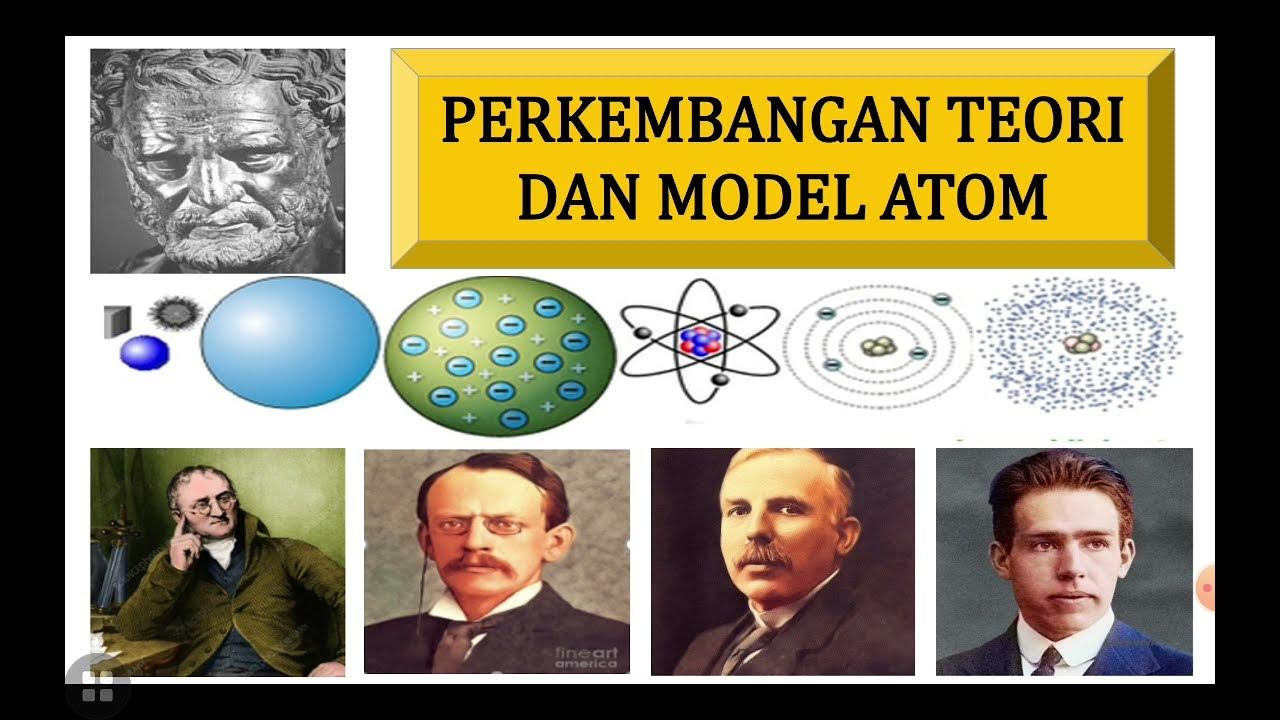SEJARAH PERKEMBANGAN TEORI ATOM
Summary
TLDRThis video explores the evolution of atomic theory, tracing its origins from ancient Greece with Democritus, who first proposed the concept of indivisible particles, to John Dalton's modern model in the 1800s. It discusses J.J. Thomson's discovery of the electron and his 'plum pudding' model, followed by Rutherford's gold foil experiment, which revealed the nucleus. Niels Bohr's refinement with quantized orbits and Schrödinger's wave mechanics model complete the narrative, showcasing the transformation of atomic theory through scientific inquiry and discovery, leading to our current understanding of atomic structure.
Takeaways
- 😀 Democritus was the first to define the atom, proposing that all matter is made up of indivisible particles called 'atomos.'
- 😀 John Dalton transformed atomic theory in the 1800s by proposing that atoms are solid spheres and that each element consists of unique atoms.
- 😀 Dalton's research established that atoms combine during chemical reactions to form compounds without changing themselves.
- 😀 J.J. Thomson discovered electrons and introduced the 'plum pudding' model, where electrons are embedded in a positively charged mass.
- 😀 Ernest Rutherford conducted the gold foil experiment, leading to the discovery of the nucleus, where positive charge is concentrated.
- 😀 Rutherford's model depicted atoms as having a central nucleus surrounded by orbiting electrons, likening it to a solar system.
- 😀 Niels Bohr improved upon Rutherford's model by introducing quantized energy levels, explaining why electrons do not spiral into the nucleus.
- 😀 Bohr's model established that electrons occupy specific orbits, jumping between them to absorb or release energy.
- 😀 Erwin Schrödinger developed the wave model of the atom, emphasizing the probabilistic nature of electron locations around the nucleus.
- 😀 The evolution of atomic theory reflects a shift from philosophical ideas to a scientific understanding grounded in experimental evidence.
Q & A
Who was the first philosopher to propose the concept of the atom?
-Democritus was the first philosopher to propose the concept of the atom, defining it as indivisible particles that make up all matter.
What was the main idea behind Democritus's theory of atoms?
-Democritus theorized that all matter is composed of tiny, indivisible particles called atoms, which vary in size and shape, and that these atoms cannot be divided further.
How did John Dalton contribute to atomic theory in the 1800s?
-John Dalton transformed the atomic theory into a modern model by conducting research on chemical combinations and proposing that all matter is made of atoms, which combine in specific ratios to form compounds.
What significant discovery did J.J. Thomson make in the 1890s?
-J.J. Thomson discovered electrons while experimenting with cathode rays, leading him to propose the 'plum pudding' model of the atom, where electrons are distributed within a positively charged sphere.
What did Rutherford's gold foil experiment reveal about the atom?
-Rutherford's gold foil experiment revealed that atoms have a small, dense, positively charged nucleus at their center, with electrons orbiting around it, challenging the previous plum pudding model.
How did Niels Bohr modify the atomic model proposed by Rutherford?
-Niels Bohr modified Rutherford's atomic model by introducing quantized energy levels for electrons, explaining that they occupy specific orbits around the nucleus without spiraling into it.
What principle did Erwin Schrödinger incorporate into his model of the atom?
-Erwin Schrödinger incorporated the Heisenberg uncertainty principle into his model, stating that it is impossible to know both the position and momentum of an electron simultaneously, leading to the concept of electron probability clouds.
What is the significance of the quantum mechanical model of the atom?
-The quantum mechanical model of the atom provides a more accurate description of electron behavior compared to classical models, allowing for predictions about atomic structure and chemical behavior based on probability.
What does string theory aim to achieve in the context of atomic theory?
-String theory aims to unify the understanding of various phenomena in physics, including the behavior of subatomic particles and forces, providing a comprehensive framework that extends beyond traditional atomic theory.
How has the understanding of atomic theory evolved over time?
-The understanding of atomic theory has evolved from philosophical concepts to scientifically validated models, with contributions from various physicists leading to a more complex and accurate picture of atomic structure and behavior.
Outlines

Dieser Bereich ist nur für Premium-Benutzer verfügbar. Bitte führen Sie ein Upgrade durch, um auf diesen Abschnitt zuzugreifen.
Upgrade durchführenMindmap

Dieser Bereich ist nur für Premium-Benutzer verfügbar. Bitte führen Sie ein Upgrade durch, um auf diesen Abschnitt zuzugreifen.
Upgrade durchführenKeywords

Dieser Bereich ist nur für Premium-Benutzer verfügbar. Bitte führen Sie ein Upgrade durch, um auf diesen Abschnitt zuzugreifen.
Upgrade durchführenHighlights

Dieser Bereich ist nur für Premium-Benutzer verfügbar. Bitte führen Sie ein Upgrade durch, um auf diesen Abschnitt zuzugreifen.
Upgrade durchführenTranscripts

Dieser Bereich ist nur für Premium-Benutzer verfügbar. Bitte führen Sie ein Upgrade durch, um auf diesen Abschnitt zuzugreifen.
Upgrade durchführenWeitere ähnliche Videos ansehen

The Atomic Theory: A Timeline Through History

SCIENCE 8: Q2_WREK 1- DAY 1: GREEK PHILOSOPHERS AND THE ATOMOS ||MATATAG CURRICULUM

GCSE Physics - Development of the model of the atom #31

Kimia X - Struktur Atom #3 | Perkembangan Teori dan Model Atom

History of the Atom (Atomic Theory)

Models of the Atom Timeline
5.0 / 5 (0 votes)
